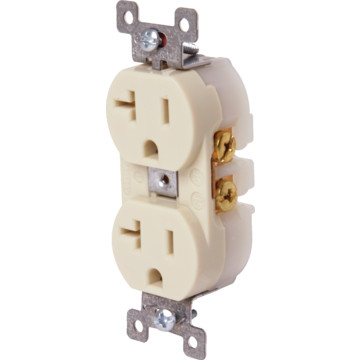myredracer
May 24, 2017Explorer II
Bad receptacle installation by factory - potentially unsafe
I removed a receptacle in our KZ Spree TT on the weekend to replace it with a black one and what I found was disturbing as can be seen in the first photo. Let this serve as a warning to RV owners out there.
The hot and neutral wires were only pushed onto one of the two terminals instead of two as specified by the manufacturer and as required by the UL/CSA certification. This means that the receptacle is only capable of carrying 1/2 it's current rating - 7 1/2 amps. Where higher rated appliances are used like say in a kitchen, this could lead to overheating. Worse, if someone has a heater plugged in and it runs non-stop for long periods of time, that would create an even higher risk of overheating. Note also that the romex/loomex cable sheath does not extend inside the receptacle housing as it is required to.
I've also found two receptacles with reverse polarity and a wire at a breaker in the converter/panel that was completely loose. KZ needs to look at their electrical practices and code compliance. I've also found numerous issues with the 12 volt wiring too. I am NOT impressed. :M
KZ is not alone though. The second photo is from a previous Coachmen Catalina TT that we used to own and you can see the hot wire connected to one terminal only there too. You can also see how the terminal was damaged and it appears that they did not use the correct tool. In two out of two TTs that I've pulled receptacles out of the wall, they've both had the same problem. Not good odds.
Receptacles in RVs are designated "SCD" for self-contained device and do not require an outlet box. These are also use in mobile homes. They are CSA or UL tested and are completely safe to use and do not ever need to be removed and replaced with a residential type (and outlet box) with screw terminals. The MUST be properly installed though and that is where RV factories are at fault. There is a special tool to "punch down" the wires onto the terminals and there is no excuse for not doing it correctly. This catalogue from Hubbell has detailed info. on their Wirecon SCD and explains how they are to be installed.
RVs are required to be wired according to the NEC, which is very detailed on what is required. Plus electrical appliances, wiring devices (recepts. & switches), wire, etc. are required to be UL or CSA certified. The problem is - there is no authority having jurisdiction or electrical engineer that is required to inspect the work for code compliance. To make it even harder, RVs are built in one state and shipped all over the US and to Canada so what AHJ would be responsible? I might consider notifying the electrical safety authority but would it be a state official or would it go to a federal authority?


The hot and neutral wires were only pushed onto one of the two terminals instead of two as specified by the manufacturer and as required by the UL/CSA certification. This means that the receptacle is only capable of carrying 1/2 it's current rating - 7 1/2 amps. Where higher rated appliances are used like say in a kitchen, this could lead to overheating. Worse, if someone has a heater plugged in and it runs non-stop for long periods of time, that would create an even higher risk of overheating. Note also that the romex/loomex cable sheath does not extend inside the receptacle housing as it is required to.
I've also found two receptacles with reverse polarity and a wire at a breaker in the converter/panel that was completely loose. KZ needs to look at their electrical practices and code compliance. I've also found numerous issues with the 12 volt wiring too. I am NOT impressed. :M
KZ is not alone though. The second photo is from a previous Coachmen Catalina TT that we used to own and you can see the hot wire connected to one terminal only there too. You can also see how the terminal was damaged and it appears that they did not use the correct tool. In two out of two TTs that I've pulled receptacles out of the wall, they've both had the same problem. Not good odds.
Receptacles in RVs are designated "SCD" for self-contained device and do not require an outlet box. These are also use in mobile homes. They are CSA or UL tested and are completely safe to use and do not ever need to be removed and replaced with a residential type (and outlet box) with screw terminals. The MUST be properly installed though and that is where RV factories are at fault. There is a special tool to "punch down" the wires onto the terminals and there is no excuse for not doing it correctly. This catalogue from Hubbell has detailed info. on their Wirecon SCD and explains how they are to be installed.
RVs are required to be wired according to the NEC, which is very detailed on what is required. Plus electrical appliances, wiring devices (recepts. & switches), wire, etc. are required to be UL or CSA certified. The problem is - there is no authority having jurisdiction or electrical engineer that is required to inspect the work for code compliance. To make it even harder, RVs are built in one state and shipped all over the US and to Canada so what AHJ would be responsible? I might consider notifying the electrical safety authority but would it be a state official or would it go to a federal authority?


